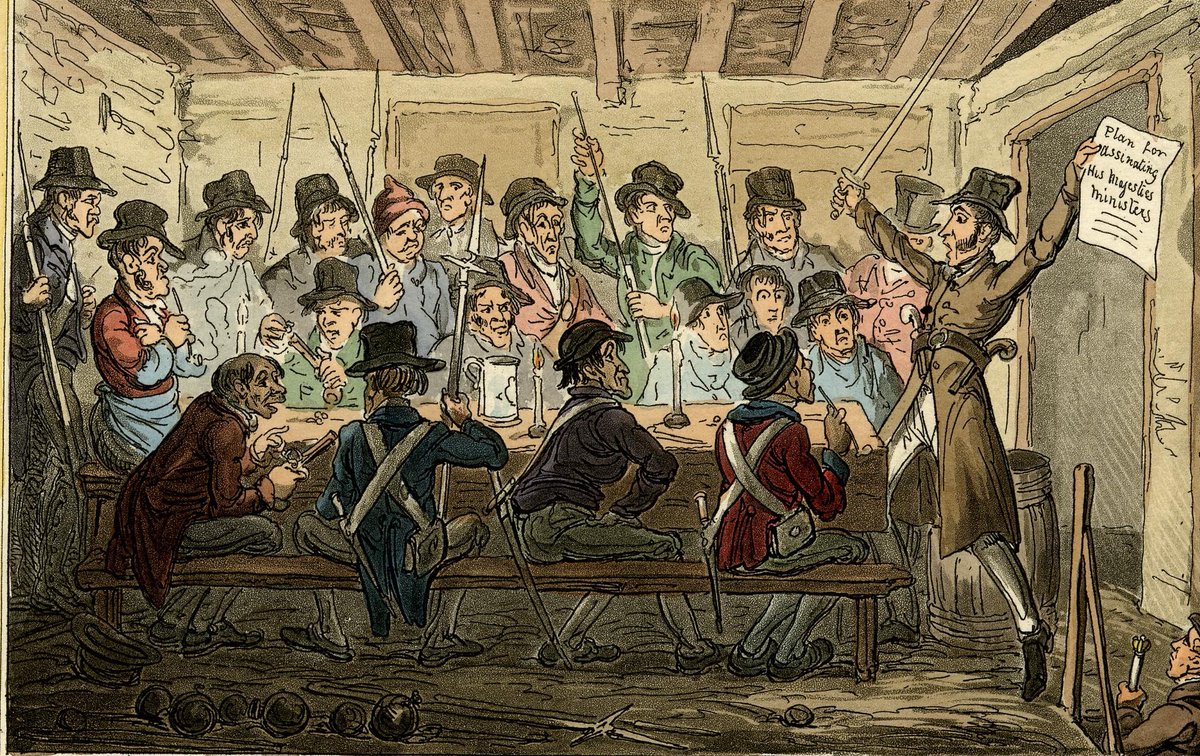Following from my last #Castlereagh200 thread, which covered the personal attacks on Castlereagh in media, it makes sense to examine 2 other stressors that increased the emotional demand on Castlereagh: fear and emotional discordance.
1/
#twitterstorians #MentalHealth #HistParl
1/
#twitterstorians #MentalHealth #HistParl

Given the level of scorn heaped on Castlereagh in the radical press, it was predictable that these writings and imagery would inspire some to action and there was no shortage of threats to the Foreign Secretary's personal safety.
2/
2/
Often, these threats took the form of street mobs. In 1815 it was necessary to have Castlereagh's house guarded by cavalry, and in 1818, after casting his vote in a by-election, Castlereagh was forced to barricade himself in a shop to avoid a crowd armed with bricks.
3/
3/
By most accounts, Castlereagh took street mobs in stride. Gronow recounts Castlereagh watching an angry crowd break the windows of his townhouse during the Corn Law riots of 1815, while observing to Gronow that "the mob is not as dangerous as you think."
4/
4/

During the Queen Caroline affair, however, threats to his safety from hostile mobs became constant because Caroline had taken up residence in a house beside Castlereagh's in St James Sq. Below is a contemporary print showing the crowd and Castlereagh's townhouse on the corner.
5/
5/

To avoid the daily hostile crowds in St James Sq, Castlereagh was advised by the Home Office to abandon his house altogether, and he moved a bed into the Foreign Office in Downing St.
Let's just consider that for a second: he had to leave his house to avoid possible violence.
6/
Let's just consider that for a second: he had to leave his house to avoid possible violence.
6/
In some cases, threats were much more targeted. During the Cato Street conspiracy, for example, there was a lengthy discussion amongst the conspirators about who would have the honour of killing and beheading the Foreign Secretary.
7/
7/

Even though Castlereagh tended to shrug off these threats, maintaining an air of indifference in the face of frequent hostility or threats would have contributed to what is now termed emotional discordance.
8/
8/
Emotional discordance can occur when an individual masks or suppresses natural feelings (e.g. fear or anxiety) in order to act in accordance with socially- or organisationally-dictated rules of behaviour.
9/
9/

This contributes to mental stress by forcing an individual to psychologically balance internal emotions and external performances that are fundamentally at odds. The political and social worlds of Regency Britain were fraught with these behavioural expectations.
10/
10/

Related to emotional discordance, it's also interesting to note that Castlereagh was, by most accounts, quite reserved by nature; one biographer termed him “a complete introvert,” and Princess Lieven found it “strange how timid he is,” and somewhat awkward in social settings.
11/
11/

While some forms of emotional labour have negative effects for both introverts and extroverts over time, there is some evidence that extroversion mediates the negative stresses...
12/
12/
...while those with more reserved personality traits don't have the same ability to mediate negative impacts, leading to more rapid emotional exhaustion and more susceptibility to stresses related to emotional dissonance.
13/
13/
For an individual who seems to have been naturally inclined towards traits of introversion, having to 'perform' continuously on multiple stages (parliamentary, cabinet, court, and social) would have exposed Castlereagh to regular emotional exhaustion.
14/14
14/14

@threadreaderapp unroll
• • •
Missing some Tweet in this thread? You can try to
force a refresh


















